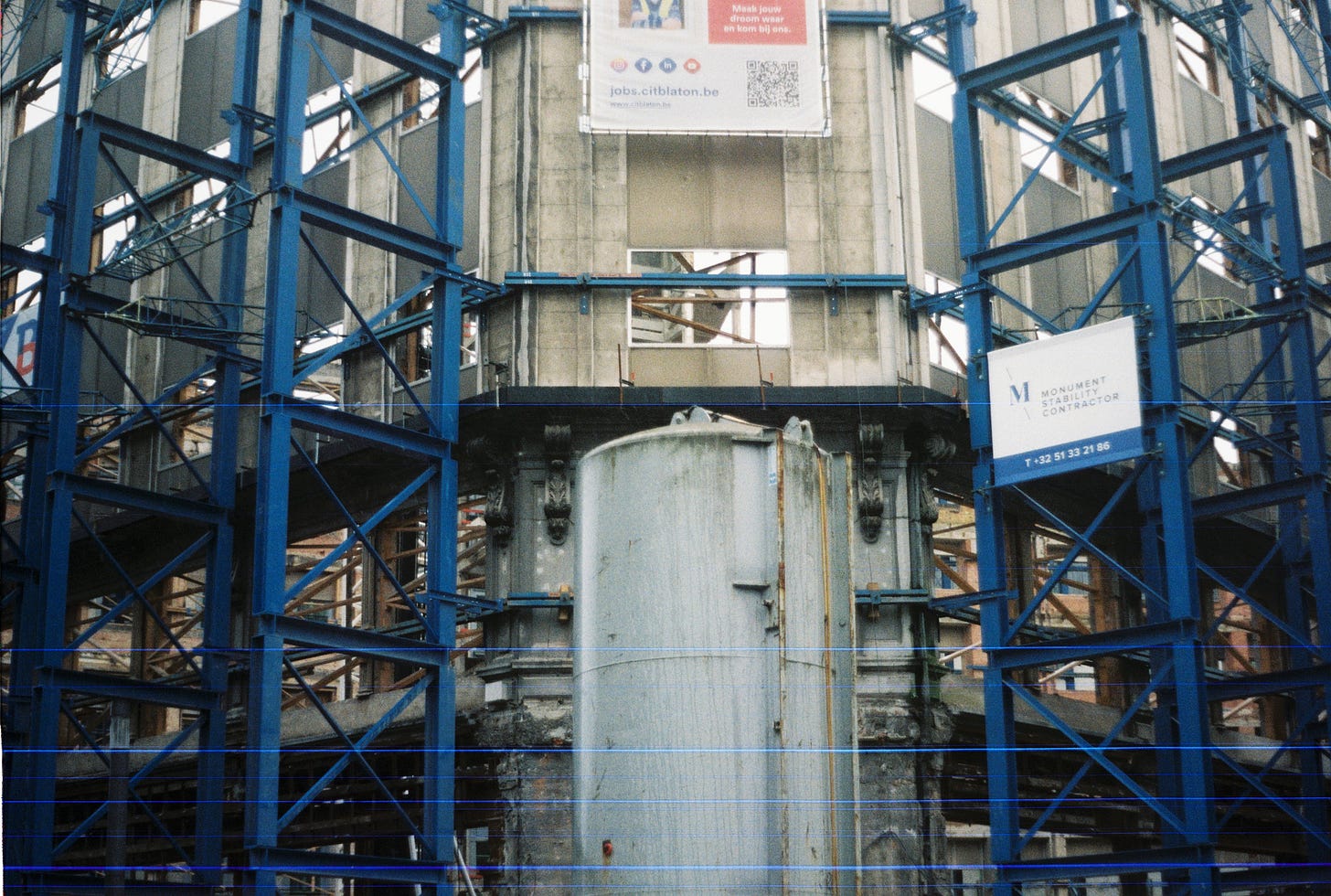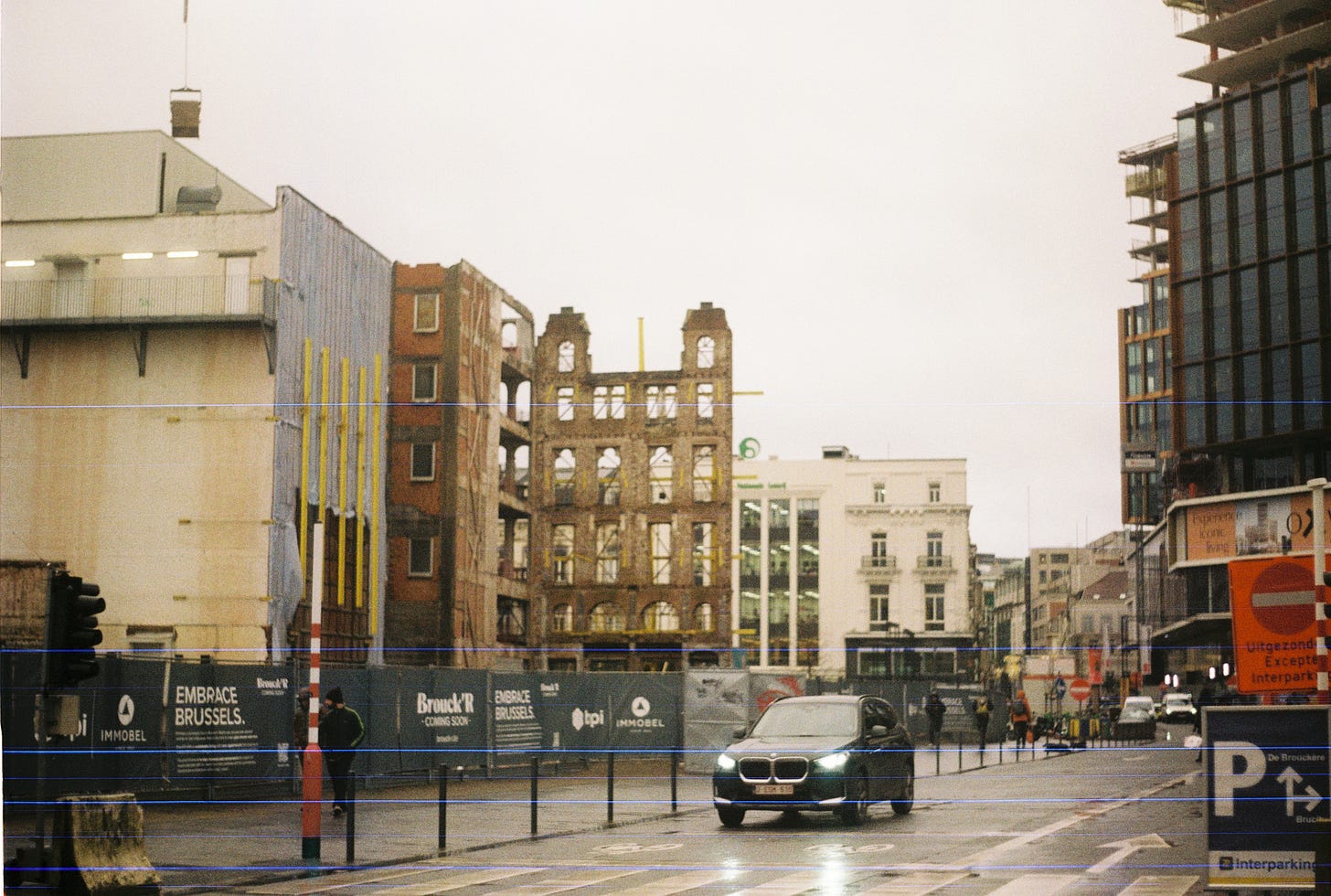I’m writer Eoghan Walsh and this is my weekly free-to-subscribe newsletter about life in Brussels. If you like it and you’re not already subscribed, you can sign up here!
For the first month of 2025, I’m taking a look in a series of articles I’ve informally titled “The State of You”, about the state of Brussels. The literal state of the place. Consider this me entering my crank era.
If you live in Brussels long enough then there is an emotion you’ve probably experienced while walking the city. Not anger, or fear, or despair, or frustration, or revulsion - though the city will provoke all of these in you easily enough. What I’m talking about is surprise.
The surprise of turning a corner to find a hole in the ground where a building used to be. That in itself isn’t very surprising; cities are constantly churning through buildings, knocking one down and erecting something new. Such is the ouroboros of urban planning. No, I’m surprised because they’ve finally knocked it down. Earlier this month I was walking up Rue de Lombard for a haircut at my usual barbers in the Sablon. Coming out the other end of the underpass, before the road turns away from the little square with the yellow flagpoles to reach the Zavel, I looked up to see that half of the Belgacom building was missing. It was as if a big bite had been taken out of the side of it, leaving only one façade on the opposite gutted but still connected to the larger office complex.
Finally, I thought. Finally they’ve managed to demolish the old thing. I’ve been reading about plans to redevelop this corner of Rue Lebeau for almost as long as I’ve lived in Brussels. I used to shop at the Taschen bookshop that was on the ground floor, before I had children and sense, and so I followed with a causal interest the glossy CGI renderings and detailed axonometric drawings published in the local papers, which tracked over many years tracked the site’s planning submissions, approvals, rescindments, re-submissions, re-approvals, court-ordered injunctions, and so on and so on. At a certain point you just give up thinking that sites like this - and the many others like it across Brussels ensnared in judicial entanglements - are ever going to change so that every time you walk past it you take note of the creeping decrepitude with a knowing resignation.
And then, one day, you turn the corner and it’s gone. Disappeared like a cheap David Copperfield trick. You don’t think, “that’s a shame” but rather “I never actually thought they’d go through with it”. Sometimes it goes the other way, and the developers knock down the building before they’ve the planning secured, and then through whatever bureaucratic hitch they catch themselves on - maybe planning is rescinded, maybe they just run out of money - this new emptied patch of gravel and twisted rebar is abandoned. Occasionally the problems are resolved quickly. Other times they’ll drag on so long you forget there was ever a hotel on that barren patch of wasteland next to the Lex building on Rue de la Loi, that it always looked like that, with the big mural proclaiming “the future is Europe” over a makeshift encampment for homeless men.
When we lived in the Marollen there was a bar on the corner of Niewland that was demolished before it caved in, with the rubble eventually cleared away and a temporary wooden fence erected around the little triangular plot. That was 11 years ago. The fence is still there, and there’s still a bombed out hole in the ground hiding behind it. Whole new ecosystems, accidental nature reserves, can emerge in the craters and half-buried foundations of these abandoned building sites. and buildings people were determined to raze but uncertain of what they could get away with building in their place. You walk past these boarded up buildings or gravel pits fenced off with sunbleached renderings of apartments that will never be built and you think, if only Brussels was a little more consistent, more predictable, if only it worked.
But this is how Brussels works, at the micro scale as with the project at Rue Lebeau, and at the macro scale for the city’s major public works. For a long time, nothing happens until suddenly everything happens after which nothing happens again. In fits and starts, a condition of punctuated equilibrium. Brussels isn't unique in this, but it does feel particularly susceptible to this rhythm. Every now and then, the people that run this city get it into their heads that something isn’t working, that something needs changing, and they are the man (historically it has been men) to make it happen. To judge by the state of the place, we are right in the middle of one of those periods of frenzied evolution.
Often the impulse for change has come from outside the city, riding into town on the back of a wider shift in the prevailing zeitgeist. In the 19th century it was panic about germ theory and dirty water that drove Jules Anspach to banish the choleric Senne to putrid underground tunnels. A century later the lure of a postwar vision of suburban modernity led planners to tear apart Brussels and put it back together with motorways and tunnels and flyovers and dirty air and traffic-clogged streets. Whole neighbourhoods like the one around Gare du Nord were eviscerated to make way for monofunctional car-centric office districts as part of a hubristic attempt to remake Manhattan on the Senne.
These days major public works are directed at reversing the deleterious effects of this monomaniacally catastrophic obsession with the car. Think bike lanes for car lanes, apartment buildings for office blocks, and the construction of the new metro line that is bogged down in the marshy soil underneath Boulevard Lemonnier. If there was an outlet for these politicians to act out their ambitions somewhere away from the city centre - virgin land where they could build a La Défense or HafenCity op zijn Brussels - the impact on us residents might be lessened. But the city is full, there aren’t any large and empty patches of land left, and its borders are inflexible - it cannot simply annex an adjacent, Flemish village next door to expand. So the city turns in on itself, constantly churning up roads and devouring buildings and boring tunnels on top of tunnels and undoing or redoing the mistakes of the past.
This is how it has to be though; because Brussel can’t grow, it has to keep moving or it will die, and take all of us with it. I just wish it didn’t thrash around so chaotically, and change direction so abruptly.
Up on Rue Lebeau, concerned citizens fought for as long as the legal process would allow them to prevent the building’s demolition. The bulldozers arrived all the same, eventually. They pulled it down and soon they’ll start building it back up again. What comes after may be better, or it may be worse. But they shouldn’t worry too much. In a few years it too will be gone. The world turns, plans are made and plans are abandoned, the snake continues to eat its own tail, and Brussels keeps changing, lurch by protracted lurch.








